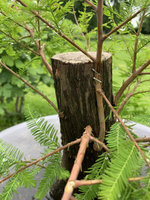Joe Dupre'
Masterpiece
Never tried this before. This tree is my "test mule". It had a rocky start. I collected it last spring and I let it flush out like normal. The customer changed his mind on it so I just brought it back to where I collected it and heeled it into the soft , slushy swamp bottom. I went back a month later and it had fallen over with the rising swamp and had sprouted more branches from the top side.......like a raft. I kinda felt sorry for it and took it back home. This year I chopped it way back to about 10" tall. It didn't throw any shoots in the top 3 inches or so , sooo I'm trying an approach graft with the most vigorous of the shoots. I removed a 1" long by 1/4" wide section of bark and stapled the shoot into it. After the pic, I wrapped the junction with a strip of plastic sheeting. We'll see how it goes.



